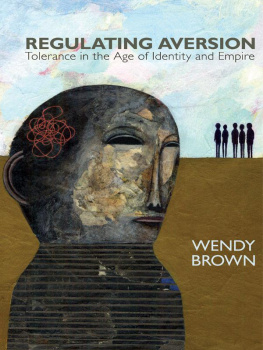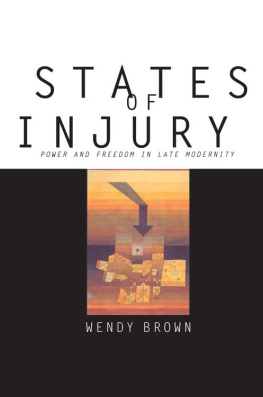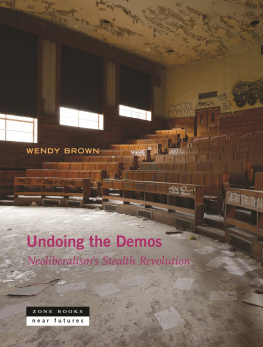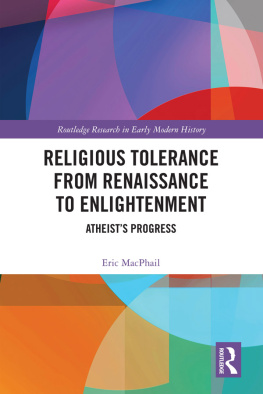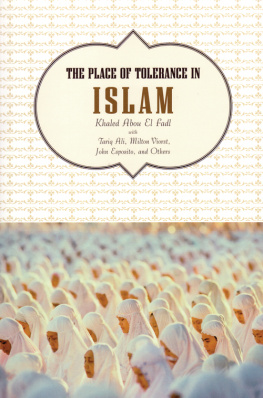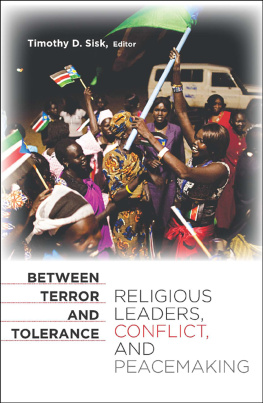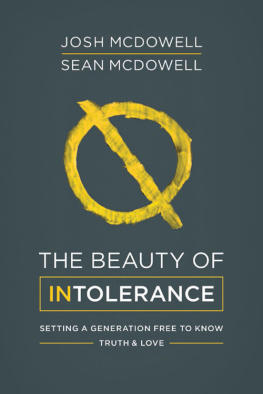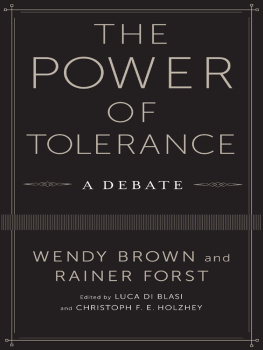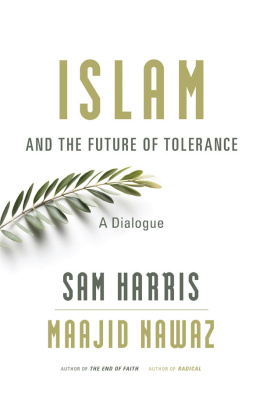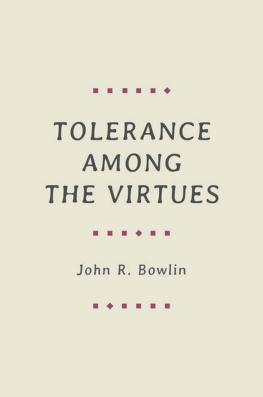REGULATING AVERSION
REGULATING AVERSION
Tolerance in the Age of Identity and Empire

Wendy Brown
PRINCETON UNIVERSITY PRESS
PRINCETON AND OXFORD
Copyright 2006 by Princeton University Press
Published by Princeton University Press, 41 William Street,
Princeton, New Jersey 08540
In the United Kingdom: Princeton University Press, 3 Market Place,
Woodstock, Oxfordshire OX20 1SY
All Rights Reserved
Third printing, and first paperback printing, 2008
Paperback ISBN: 978-0-691-13621-9
The Library of Congress has cataloged the cloth edition of this book as follows Brown, Wendy.
Regulating aversion : tolerance in the age of identity and empire / Wendy Brown.
p. cm.
Includes index.
ISBN-13: 978-0-691-12654-8 (hardcover : alk. paper)
ISBN-10: 0-691-12654-2 (hardcover : alk. paper)
1. Toleration. I. Title.
HM1271.B76 2006
179.9dc22 2005036547
British Library Cataloging-in-Publication Data is available
This book has been composed in Sabon
Printed on acid-free paper.
press.princeton.edu
Printed in the United States of America
3 5 7 9 10 8 6 4
For Lila and Gail
CONTENTS
ACKNOWLEDGMENTS
Over six years of working intermittently on this book, I have acquired many debts. Rainer Forst sparked the project with his invitation to revisit Marcuses essay Repressive Tolerance for his own edited volume on tolerance. Val Hartouni made the first visit to the Simon Wiesenthal Museum of Tolerance with me and brought her subtle intelligence to bear on my early efforts to conceptualize the strange province of tolerance. Neve Gordon took time to answer my questions about Hebrew terms and (the general absence of) tolerance discourse in Israel. Lila Abu-Lughod gave me things to read, spotted errors in my arguments, and put gentle pressure on my Euro-Atlantic habits of seeing and thinking. Joan W. Scott, Elizabeth Weed, Barry Hindess, Michel Feher, Caroline Emcke, and William Connolly each engaged carefully with one or more chapters. Judith Butler, Melissa Williams, and an anonymous reviewer read the entire manuscript in draft; their criticisms were invaluable as I revised.
In his discerning and disarming way, Stuart Hall suggested that I loosen rather than tighten the analytic noose around liberalism that I was readying in the final two chapters. His reminder that colonial discourse cannot be wholly resolved into liberalism saved me from foolishness. Around the same time, Mahmood Mamdani reminded me that the discursive practices emanating from the settler-native encounter are distinct from a liberal democracys practices for managing its internal others. These convergent readings strengthened the books argument that tolerance discourse is continuously remade and redirected by encounters with new historical turns and new objects.
At the penultimate phase of revising, Gail Hershatter provided me with an office, plied me with her wondrous cooking, and, during one early morning run in the woods, persuaded me not to start the book over. Judith Butlers own work, her reading of mine, and our persistent disagreements have enriched my thinking more than anything else over the past fifteen years. That I am also graced by her love is fortune beyond measure.
Many audiences have responded usefully to presentations of this work in progress; I am particularly grateful for the rich engagements with it in Canada and England, two lands that have become second intellectual homes for me. I have also had wonderful research assistance. Catherine Newman scouted background information on the Museum of Tolerance. Robyn Marasco completed citations, located speeches based on phrases I recalled from radio newscasts, tracked down odd facts and sources, and much more. Colleen Pearl did a final cleanup on the manuscript that left me in awe; she also prepared the index. Ivan Ascher good-naturedly lent me his French fluency to study Foucaults untranslated lectures.
Ian Malcolm of Princeton University Press, one of the finest editors in the trade, handled this book expertly. My debts to Alice Falk, my copyeditor, are too large to repay in this lifetime.
Initial institutional support for this project came from the Division of Humanities and the Academic Senate Committee on Research at the University of California, Santa Cruz. Later, I was the recipient of a Humanities Research Fellowship from the University of California, Berkeley; an American Council of Learned Societies Fellowship; and a residential fellowship at the Institute for Advanced Study in Princeton. Anyone who has spent a year at the Institute knows what an incomparable environment it is for thinking and writing. For this, I am especially indebted to Michael Walzer and Joan W. Scott.
Portions of this book have appeared, in different form, in the following publications: Parts of was adapted from Tolerance As/In Civilizational Discourse, Finnish Yearbook of Political Science (2004).
REGULATING AVERSION
ONE

TOLERANCE AS A DISCOURSE OF DEPOLITICIZATION
Cant we all just get along?
Rodney King
An enemy is someone whose story you have not heard.
epigraph of Living Room Dialogues on the Middle East
Tolerance is not a product of politics, religion or culture. Liberals and conservatives, evangelicals and atheists, whites, Latinos, Asians, and blacks are equally capable of tolerance and intolerance. [T]olerance has much less to do with our opinions than with what we feel and how we live.
Sarah Bullard, Teaching Tolerance
How did tolerance become a beacon of multicultural justice and civic peace at the turn of the twenty-first century? A mere generation ago, tolerance was widely recognized in the United States as a code word for mannered racialism. Early in the civil rights era, many white northerners staked their superiority to their southern brethren on a contrast between northern tolerance and southern bigotry. But racial tolerance was soon exposed as a subtle form of Jim Crow, one that did not resort to routine violence, formal segregation, or other overt tactics of superordination but reproduced white supremacy all the same. This expos in turn metamorphosed into an artifact of social knowledge: well into the 1970s, racial tolerance remained a term of left and liberal derision, while religious tolerance seemed so basic to liberal orders that it was as rarely discussed as it was tested. Freedom and equality, rather than tolerance, became the watchwords of justice projects on behalf of the excluded, subordinated, or marginalized.
Since the mid-1980s, however, there has been something of a global renaissance in tolerance talk. Tolerance surged back into use in the late twentieth century as multiculturalism became a central problematic of liberal democratic citizenship; as Third World immigration threatened the ethnicized identities of Europe, North America, and Australia; as indigenous peoples pursued claims of reparation, belonging, and entitlement; as ethnically coded civil conflict became a critical site of international disorder; and as Islamic religious identity intensified and expanded into a transnational political force. Tolerance talk also became prominent as domestic norms of integration and assimilation gave way to concerns with identity and difference on the left and as the rights claims of various minorities were spurned as special rather than universal on the right.
Today, tolerance is uncritically promoted across a wide range of venues and for a wide range of purposes. At United Nations conferences and in international human rights campaigns, tolerance is enumerated, along with freedom of conscience and speech, as a fundamental component of universal human dignity. In Europe, tolerance is prescribed as the appropriate bearing toward recent Third World immigrants, Roma, and (still) Jews and as the solution to civil strife in the Balkans. In the United States, tolerance is held out as the key to peaceful coexistence in racially divided neighborhoods, the potential fabric of community in diversely populated public schools, the corrective for abusive homophobia in the military and elsewhere, and the antidote for rising rates of hate crime. Tolerance was the ribbon hung around the choice of an orthodox Jew for the Democratic vice presidential nominee in the 2000 presidential elections and the rubric under which George W. Bush, upon taking office in his first term, declared that appointees in his administration would not have their sexual orientations scrutinized or revealed. Schools teach tolerance, the state preaches tolerance, religious and secular civic associations promulgate tolerance. The current American war on terrorism is being fought, in part, in its name. Moreover, even as certain contemporary conservatives identify tolerance as a codeword for endorsing homosexuality, Combined with this bewildering array of sites and calls for tolerance is an impressive range of potential objects of tolerance, including cultures, races, ethnicities, sexualities, ideologies, lifestyle and fashion choices, political positions, religions, and even regimes.
Next page
